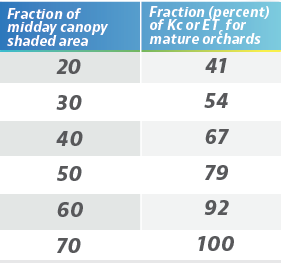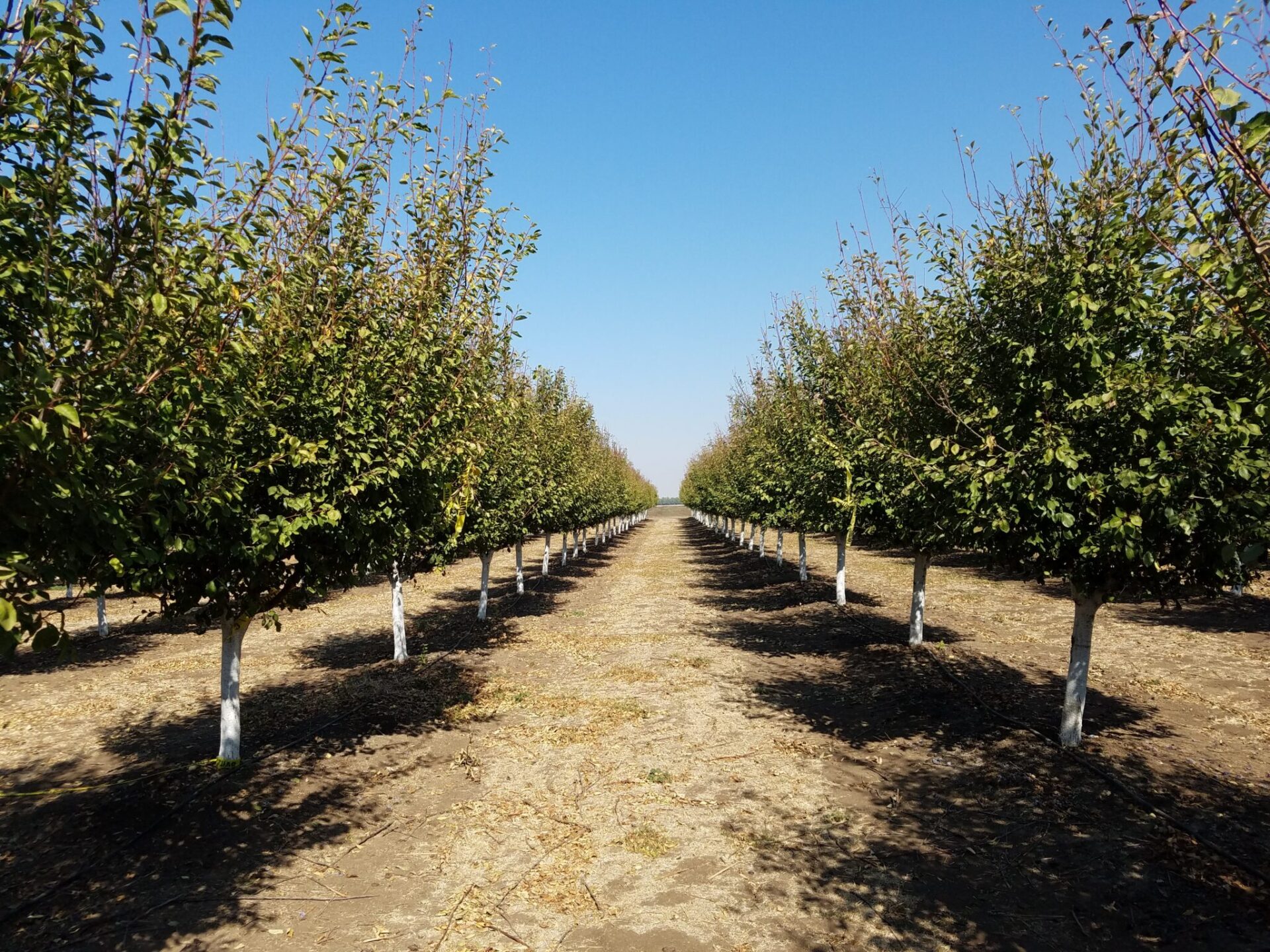As the 2020 fall harvest season ends and we turn toward the winter season, there is an opportunity to reflect upon the past irrigation season and prepare for 2021 by looking for irrigation management information. Good irrigation management involves understanding your irrigation system and utilizing available information to decide how much to irrigate and when. Many resources are available to inform your irrigation management and allow you to refine your 2021 irrigation plan.
Getting Irrigation Right
We principally think of irrigation management affecting tree and crop development as spring/summer shoot growth, fruit and nut development, bud development for next year’s crop and uniform crop maturity. While this is true, irrigation management impacts several other aspects of your orchard including disease and pest pressures, nutrient and salinity management and costs.
As an orchard becomes established, irrigation management influences disease pressure. The orchard provides the host plants for various pathogens (Phytophthora, Monilinia, Rhizopus and others,) and irrigation affects whether the orchard environment is favorable for the disease to aggressively infect the trees or not. Later-season crop development affects pest control (i.e. navel orangeworm), harvest efficiency and the vitality of next season’s fruit buds. Irrigation also affects postharvest tree condition and risk of fall frost damage and winter cold injury. Throughout the season, irrigation management impacts energy and fertilizer costs as well as salinity management where it is a concern.
Irrigation management is further compounded in the early years of orchard establishment when tree size is rapidly changing. Irrigation management can affect the rate of tree growth and time for an orchard to begin to produce. Irrigation interacts with pruning, tree training, number of replants and uniformity of a young orchard.
Irrigation System Performance
Attention to irrigation system performance is an important part of irrigation management. Knowing the average hourly water application rate of a pressurized irrigation system and having a sense of how uniformly water is applied across an orchard gets at the crux of irrigation system performance. Without knowing the hourly water application rate, it is difficult to translate how the hundreds of hours of irrigation throughout a season relate to crop water use and assess how well seasonally applied water met the crop needs. It is equally as important to know whether the average hourly rate of water applied was uniform across the orchard. Irrigation uniformity is dependent upon the irrigation system design, maintenance and repair practices.
Some resource conservation districts in the Central Valley have a history of offering mobile irrigation lab services to support growers. These labs are available to perform on-farm evaluations of irrigation system performance. Below are two suggestions to explore. If they cannot provide an evaluation on your farm, perhaps they can suggest some alternatives.
Northwest Kern Resource Conservation District.
kerndelta.org/wp-content/uploads/2020/01/Mobile-Lab-Flyer-2020.pdf
Resource Conservation District of Tehama County
tehamacountyrcd.org/services/lab2.html
Wondering if you might be able to do it yourself? Check out the UC-ANR publication titled “Irrigation and Nitrogen Management”. Page 5 describes how to perform a rapid evaluation of irrigation system distribution uniformity. Also, the Almond Board of California provides a short four-minute video describing a more detailed method similar to that used by the irrigation mobile labs.
California Institute for Water Resources: Irrigation and Nitrogen Management
ciwr.ucanr.edu/files/300671.pdf
Almond Board of California: Irrigation Tools
http://www.almonds.com/tools-and-resources/grower-tools/irrigation-tools
Irrigation Scheduling
An irrigation system application rate feeds into using irrigation scheduling tools. Irrigation scheduling involves deciding if irrigation is needed, and if so, when to apply it and how much water to apply. Irrigation scheduling is effective when the irrigation system applies water at a high level of uniformity.
An assortment of irrigation scheduling tools is available to growers to help determine when to run their irrigation system and for how long. Generally, these tools either monitor weather conditions, soil moisture levels or tree water status. Weather is monitored to estimate daily crop evapotranspiration (ETc) rates and determine if the amount of water from irrigation, rainfall and soil storage appears in balance with crop water use. Soil moisture may be monitored at different soil depths to help maintain reasonable levels of soil moisture throughout the growing season. Tree water status may be monitored as a direct indicator of an orchard’s irrigation needs, the effective root zone and how the trees are integrating weather and soil-water conditions.
Self-Study Irrigation Resources
Self-study irrigation video tutorials and podcasts are available to assist learning and development of irrigation management skills and practices. Some examples with brief descriptions are listed below:
sacvalleyorchards.com/et-reports/et-how-to-video-series or curesworks.org/cecourses
The self-study videos provided at the above websites offer the same content with a few differences. The video series offered on both websites is sponsored by UC ANR. It offers 3.5 hours of instruction for using regional reports of real-time crop evapotranspiration and knowledge of irrigation system performance to schedule irrigations. It considers young developing and established orchards. It also discusses integrating soil moisture and tree water status monitoring to help make irrigation management decisions. The series wraps up looking to the future of orchard irrigation management technology and approaches. The Sacramento Valley Orchards blog provides the video series in shorter segments for greater viewing flexibility, but does not offer continuing education credits. The Curesworks website offers the video series in five segments (each 0.5 to 1.0 hour long) with post-testing available to acquire continuing education credits if needed.
curesworks.org/cecourses/ or growingthevalleypodcast.com
Again, there is some overlap and differences in the podcasts provided at these websites. Four 30-minute podcasts are offered at the Curesworks website (bottom of the page.) Post-testing is available to receive continuing education credits. Topics include irrigation and tree health, basic irrigation monitoring, irrigation management with plant stress and optimizing the irrigation system. The same irrigation management podcasts plus other orchard management topics are available at the “Growing the Valley Podcast” website without the post-testing and continuing education credits.
sacvalleyorchards.com/et-reports/et-calculators/
A series of calculators is available at this link. They help you apply the irrigation management lessons offered in the videos and podcasts summarized above to your farm. Specifically, the calculators help you find out how much water your system applies and then how long to irrigate based on ET and your system’s output.
ciwr.ucanr.edu/California_Drought_Expertise/Insights__Water_and_Drought_Online_Seminar_Series/
This online video seminar series dates back to 2013-14 and consists of about 40 different videos. It is sponsored by UC’s California Institute for Water Resources. Its focus is drought preparedness and drought management strategies. It provides discussions from “big picture” perspectives but also drills down to field level management practices. Specifically, there is a section on “Crop management practices under limited water supply: Permanent crops”. No post-testing or continuing education credits are offered with this seminar series. Even if water at your orchard is not limited at the moment, you may want to save this link for future reference.
Sample from Video Tutorials: Young Orchard Irrigation
A variety of information is discussed in the video tutorials discussed above. One focus is utilizing weekly regional ETc reports to inform water needs, and help decide when to irrigate and how long to run an irrigation system. These reports provide estimates of water use for mature orchards that are in production. A common question is: how to modify the information in these reports for use in newly planted orchards with initially smaller but rapidly growing canopies (see Figure 1)?

In these videos, a simple methodology is suggested and demonstrated to modify the weekly reported rates of crop water use (ET) to reflect varying tree age and size (See Figure 2). It involves use of a midday digital photo and applying science-based relationships between canopy size (light interception) and ETc. As new research is reported, this relationship may be updated.

There are plenty of sources of great information on how to optimize your irrigation management. We’ve experienced that the best management comes from integrating multiple sources of information including weather, soil and plant stress measurements. Winter is a great time to reflect on and learn from a wide variety of resources to help in that decision-making process.

















